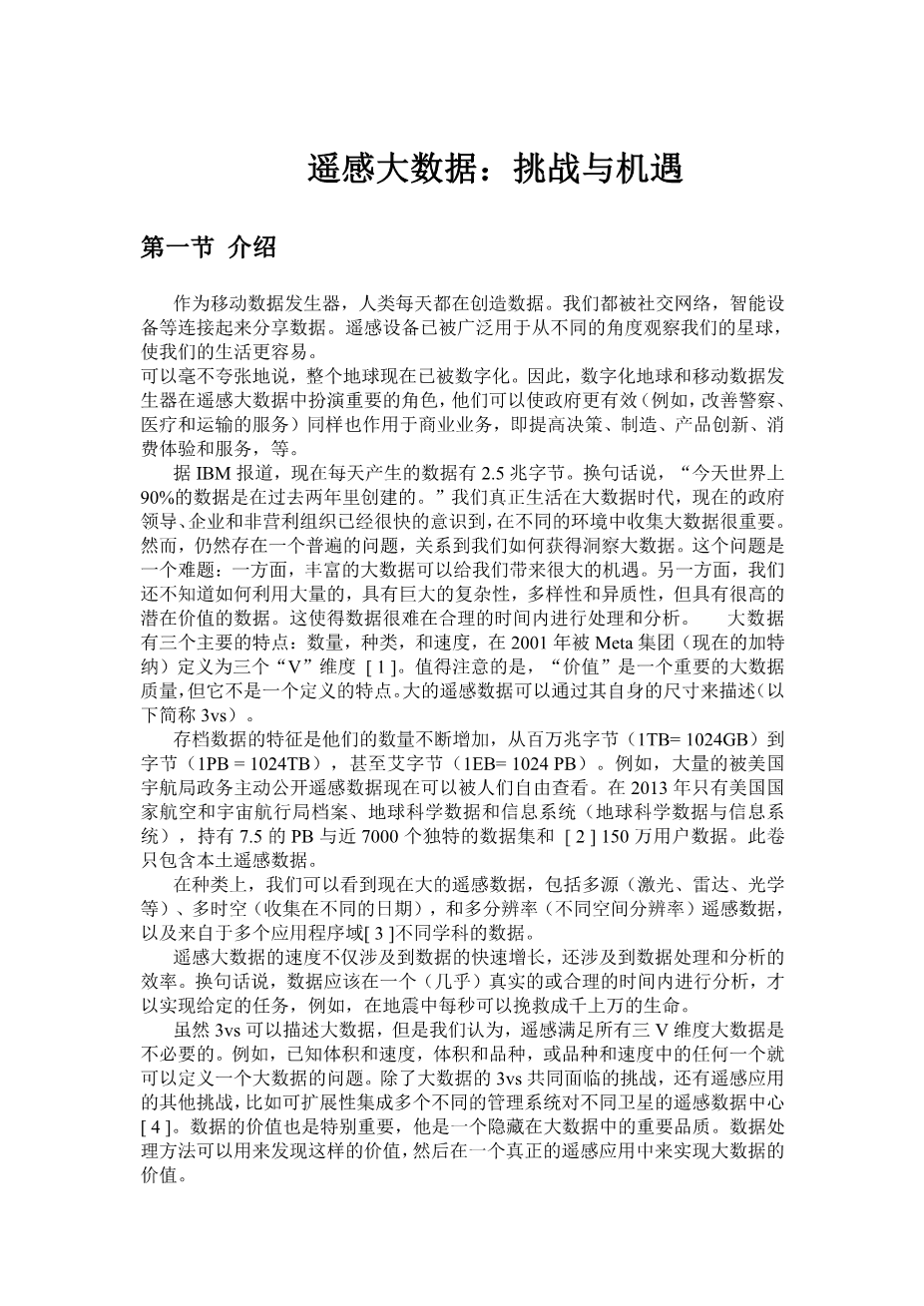Big Data for Remote Sensing: Challenges and Opportunities
SECTION I INTRODUCTION
As moving data generators, human beings create data everyday. We are all connected by sharing data from social networks, intelligent devices, etc. Remote sensing devices have been widely used to observe our planet from various perspectives and to make our lives easier. It is not exaggerated to say that the whole Earth has now been made digital. Therefore, the digitized Earth plus the moving data generators are the main actors for big data in remote sensing, which can be used to make governments more efficient (e.g., improving services like police, healthcare and transportation) and also for business, i.e., to improve decision making, manufacturing, product innovation, consumer experience and service, etc.
As reported by IBM, 2.5 quintillion bytes of data are now generated every day. In other words, “90% of the data in the world today has been created in the last two years alone.”1 We are truly living in the big data age, and now government leaders, enterprises, and nonprofit organizations are quickly realizing that it is very important to collect big data in different contexts. However, there still exists a common problem related to how we can gain insights into big data. This problem is a conundrum: On one hand, a wealth of big data can bring us big opportunities. On the other hand, we still do not know how to harness such big amount of data with tremendous complexity, diversity, and heterogeneity, yet with high potential values. This makes the data very difficult to process and analyze in a reasonable time.2
Big data can be mainly characterized by three features: volume, variety, and velocity, defined as three “V” dimensions by Meta Group (now Gartner) in 2001 [1]. It is worth noting that “value” is an important quality of big data, but it is not a defining characteristic. Big remote sensing data can be described by its own dimensions (referred hereinafter as 3Vs).
The archived data are characterized by their increasing volume, from terabytes (TB $=$ 1024 GB) to petabytes (PB $=$ 1024 TB), and even to exabytes (EB $=$ 1024 PB). For instance, a huge amount of remote sensing data are now freely available from the NASA Open Government Initiative.3 Only one of NASA archives, the Earth Science Data and Information System (ESDIS), holds 7.5 PB of data with nearly 7000 unique data sets and 1.5 million users in 2013 [2]. This volume only contains in-domain remote sensing data.
In terms of variety, we can see now that big remote sensing data consist of multisource (laser, radar, optical, etc.), multi-temporal (collected on different dates), and multi-resolution (different spatial resolution) remote sensing data, as well as data from different disciplines depending on several application domains [3].
The velocity of big data in remote sensing involves not only generation of data at a rapid growing rate, but also efficiency of data processing and analysis. In other words, the data should be analyzed in a (nearly) real or a reasonable time to achieve a given task, e.g., seconds can save hundreds of thousands of lives in an earthquake.
Although the 3Vs can describe big data, we consider that it is not necessary for big data in remote sensing to satisfy all the three V dimensions. For instance, any one of volume and velocity, volume and variety, or variety and velocity can already define a big data problem. Except for the common challenges of big data characterized by the 3Vs, there are other challenges for the remote sensing applications, such as extensibility to integrating multiple disparate management systems for different satellites for a remote sensing data center [4]. Of particular importance is the value of the data, an important quality hidden in the big data. Data processing methods can be utilized to discover such value, and then the value of big data can be realized in a real remote sensing application.
Therefore, to better understand big data, three perspectives should be unified, i.e., owning data, data applications, and data methods. In the paper, a trinity framework is proposed to better understand big data in the context of remote sensing applications. All the facets of such trinity share common challenges and different perspectives have individual challenges of its own.
In this work, these common and individual challenges are discussed in the context of remote sensing applications. In spite of such big challenges, the potentials of big remote sensing data are presented in detail. These potentials have been applied to deal with different real-world problems, such as archaeology [5], crop assessment and yield forecasting [6], [7], food security [8], human health [9], [10], land development and use [11], urban planning, management, and sustainability [
lt;a data-cke-saved-href='http://ieeexplore.ieee.org/
资料编号:[613742],资料为PDF文档或Word文档,PDF文档可免费转换为Word
课题毕业论文、文献综述、任务书、外文翻译、程序设计、图纸设计等资料可联系客服协助查找。


